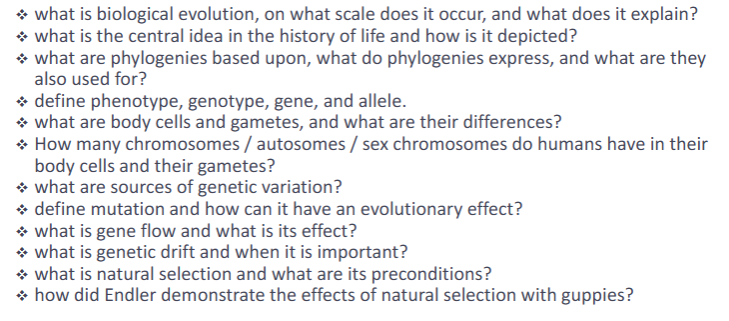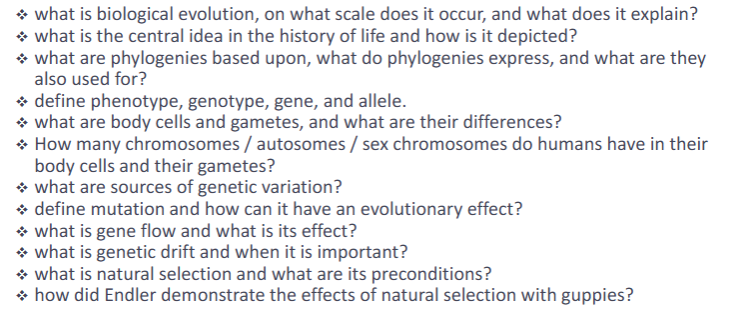ANP 220 Fundamentals of evolutionary theory I
1/22
There's no tags or description
Looks like no tags are added yet.
Name | Mastery | Learn | Test | Matching | Spaced |
|---|
No study sessions yet.
23 Terms
example of class topics
evolution of bipedality
possible benefits of bipedality (=effects of natural selection
culture and spread of the disease
possible benefits of genetic disease or chance (effects of natural selection or genetic drift/ founder effects/lack of gene flow
human diversity
adaptation to environments/culture (-effects of natural selection, gene flow, etc.)
biological evolution
definitions and patterns - descent with modification (change through time)
small-scale population level - microevolution - genetic inheritance
large- scale - species level - macroevolution
→ explains biodiversity
genetic inheritance
phenotypes genotypes, DNA, genes, and alleles
energetic variation and mechanisms of genetic change
mutation, gene flow, genetic shuffling and sex, genetic drift, and natural selection
history of life central idea
species share common ancestors
depicted through a family tree, phylogeny
based on similarities also used for classification
phylogeny
= evolutional relationships among organisms (phylogeny w/o time = cladogram)
process of evolution
descent with inherited modifications
change through time; genetic inheritance
relies on genetic variation - is driven by 4 mechanisms (mutation gene flow, genetic drift; natural selection, sexual reproduction
gene
part of a chromosome that encodes a gene product
proteins responsible for the structure, functions and regulation of the body tissues and orans
receptor hormones, oxygen transport, antibodies
same or different on homologous chromosomes
body cells
two chromosomes of a particular kind
gametes
one chromosome of a particular kind
sex cells that join e and sperm to combine hereditary information
mechanisms of evolutionary change
non-adaptive - mutation - gene flow - genetic drift
adaptive - natural selection - sexual selection
sources of genetic variation
mutation in gametes, gene flow, genetic shuffling, and sexual reproduction
mutation
(random) changes in genetic information - can be harmful, neutral, or beneficial
evolutionary effects of mutations
DNA changes in gametes
pass on to next generation
more soucres of genetic variation
mutation in gametes - new genetic info passed on to offspring
gene flow -new genetic info into a population - passed onto offspring
genetic shuffling and sexual reproduction - new combination of genetic info passed on to offspring - combo of parent's genetic info
gene flow
movement of organisms to a new place
introduction of new genetic material
increases genetic variation in a population
genetic shuffling and sexual reproduction
new combination of genetic info passed on to offspring
combination of parents’ genetic
genetic drift - change in allele frequency due to chance
always present
effects - reduces variation - may lead to speciation - stronger in small populations
importamce of genetic drift
controversial - neutral theory of evolution
most variation because of nutation and genetic drift
may have a strong effect
some variation accumulated because of genetic drift - RANDOM process
grandfathers of evolutionary theory
Charles Darwin and Alfred Russel Wallace
how to explain biodiversity
evolution by means of natural selection
preconditions for natural selection
inheritance - genetic variation - environmental pressure (filter which selects advantage traits
→ results (natural selection)
individuals with advantageous traits survive better and have more offspring
advantageous traits will be more common in the next generation (mire individuals have the trait)

learning objective or ‘what you should know’
